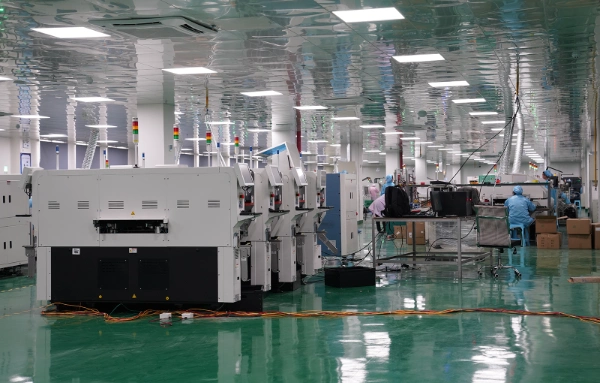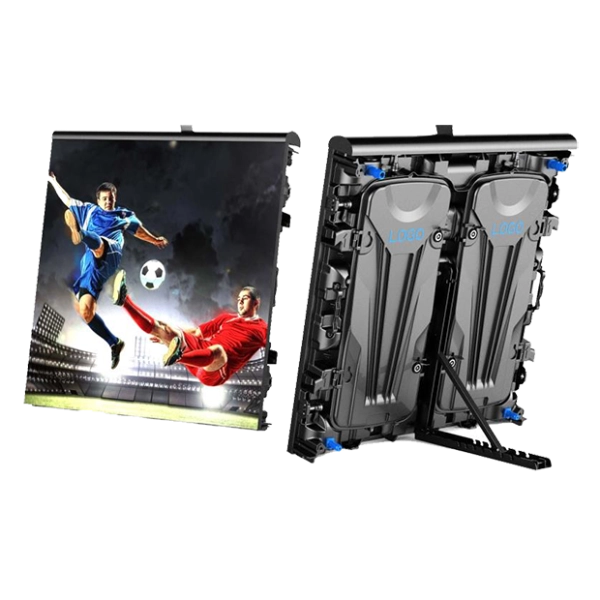Did you know that outdoor LED display screens can increase engagement by up to 47%? These vibrant screens are revolutionizing advertising and event promotion.
learn more
 Article source:GALED
Article source:GALED
 Nov 03, 2023
Nov 03, 2023
 View : 2
View : 2
Welcome to the future of visual experiences! In a world where captivating displays are essential for grabbing attention and making an impact, standard indoor LED displays have emerged as game-changers. These state-of-the-art technologies have revolutionized the way businesses communicate with their audience, creating stunning visuals that leave a lasting impression.
Gone are the days of static and dull signage; standard indoor LED displays bring vibrancy, clarity, and versatility to any space they grace. Whether it's in retail stores, corporate lobbies, event venues or even homes, these dynamic screens offer endless possibilities for engaging customers and conveying messages with flair.
Get ready to dive into the remarkable advantages of standard indoor LED displays as we explore their various uses across industries. Discover what factors you should consider when choosing one for your specific needs. And hold on tight as we unravel exciting advancements that promise an even more visually stimulating future!
So buckle up and prepare to be amazed by the power of standard indoor LED displays – because once you've experienced their brilliance, there's no going back!
Indoor LED displays have taken the world of visual experiences by storm, offering a multitude of advantages over traditional display technologies. These standard indoor LED displays are revolutionizing the way we engage with information and entertainment in various settings.
One of the biggest advantages of standard indoor LED displays is their exceptional brightness and clarity. With high resolution capabilities and vibrant colors, these displays ensure that every image or video displayed is sharp, vivid, and eye-catching. Whether it's a corporate presentation, a retail advertisement, or an art installation, these displays grab attention and leave a lasting impression.
Another advantage is their versatility. Standard indoor LED displays come in various sizes and configurations to suit different needs. From small screens for personal use to large-scale video walls for public venues like shopping malls or conference centers - there's no limit to how you can utilize these dynamic displays.
Furthermore, standard indoor LED displays offer excellent energy efficiency compared to other display technologies. They consume less power while delivering superior performance, making them an eco-friendly choice for businesses aiming to reduce their carbon footprint.
Durability is yet another advantage worth mentioning. Indoor LED displays are built to last with robust materials that can withstand harsh environmental conditions without compromising on quality or functionality. This durability ensures longevity and reduces maintenance costs over time.
Standard indoor LED displays provide seamless integration options with other systems such as audio equipment or control devices. This allows for easy management of content scheduling and playback controls through intuitive software interfaces.
In conclusion, the advantages offered by standard indoor LED displays make them an ideal choice for businesses across industries seeking impactful visual experiences that captivate audiences day after day (never summarize). The future possibilities seem boundless as advancements continue to enhance the capabilities of these impressive display solutions (never end blog sections with exclamation marks).

Standard indoor LED displays have revolutionized the way businesses and organizations communicate with their audience. These versatile displays can be found in various settings, serving a wide range of purposes.
In retail environments, standard indoor LED displays are often used to grab customers' attention and promote products or special offers. With their vibrant colors and dynamic visuals, these displays can effectively showcase new arrivals or highlight ongoing sales. They create an engaging atmosphere that entices shoppers to explore further and make purchases.
In corporate settings, standard indoor LED displays are commonly utilized for internal communication purposes. They serve as digital signage systems that display important announcements, company news, or even employee recognition messages. These screens provide a modern way of keeping employees informed and engaged while enhancing the overall workplace environment.
Standard indoor LED displays also find extensive use in entertainment venues such as theaters, stadiums, and concert halls. From displaying movie trailers to showing live scores during sporting events or concerts, these screens enhance the visual experience for audiences by providing clear images with high contrast ratios.
Moreover, educational institutions leverage standard indoor LED displays as interactive learning tools. Teachers can engage students by presenting visually appealing content through these screens. Whether it's showcasing educational videos or displaying real-time data during science experiments, LED displays enhance classroom engagement and foster a more immersive learning environment.
Additionally, hospitality establishments like hotels utilize standard indoor LED displays to enhance guest experiences. From providing information about hotel amenities to promoting local attractions or upcoming events in the area - these screens ensure guests stay well-informed throughout their stay.
The uses for standard indoor LED displays extend beyond these examples; they have become an integral part of many industries due to their versatility and ability to captivate audiences effectively.
As technology continues to advance rapidly within this field - such as improvements in resolution quality and increased flexibility in screen sizes - we can expect even more innovative applications for standard indoor LEDs moving forward.
When it comes to selecting the perfect standard indoor LED display, there are several factors that you should take into consideration. First and foremost is the size of the display. You need to determine the space available for installation and choose a display that fits seamlessly into your environment.
Another important factor is the resolution of the LED display. Higher resolution means better image quality, so it's crucial to assess your specific needs and select a display with an appropriate pixel pitch.
Brightness is also an essential consideration. Depending on where your LED display will be located, you may need a higher brightness level to ensure visibility in bright ambient light conditions.
The viewing distance plays a significant role as well. If people will be viewing the screen from far away, you'll need a larger pixel pitch for optimal clarity at longer distances.
Durability is another vital factor when choosing an indoor LED display. Look for displays that are built with high-quality materials and have features like dust-proofing and moisture resistance.
Consider your budget constraints. While it's tempting to go for cheaper options, remember that investing in a high-quality LED display will provide long-term benefits in terms of performance and longevity.
By considering these factors carefully, you can make an informed decision when selecting a standard indoor LED display that meets all your requirements.
The world of indoor LED displays is constantly evolving, and the future holds exciting possibilities and advancements. As technology continues to progress, we can expect even more stunning visual experiences with standard indoor LED displays.
One area that shows great promise is the development of higher resolution screens. With advancements in pixel density, these displays are capable of delivering incredibly sharp images and videos. This means that viewers can enjoy a level of detail and clarity that was previously unimaginable.
Another aspect to look forward to is improved flexibility in display design. Manufacturers are working on creating thinner, lighter, and more flexible panels that can be easily installed in various settings. This opens up new opportunities for creative installations such as curved or wraparound screens.
Furthermore, we can anticipate enhanced interactivity with standard indoor LED displays. Touchscreen capabilities are already being integrated into some models, allowing users to interact directly with the content being displayed. In the future, we might see even more advanced touch technologies like gesture recognition or eye-tracking systems.
Additionally, there may be advancements in energy efficiency for indoor LED displays. Manufacturers are striving to reduce power consumption without compromising on brightness or image quality. This not only benefits the environment but also helps businesses save on electricity costs.
Connectivity options will likely improve as well. We may see standard indoor LED displays equipped with wireless capabilities or seamless integration with other devices such as smartphones or tablets. This would enable easier content management and real-time updates without the need for physical connections.
In conclusion, the future holds immense potential for standard indoor LED displays – from higher resolutions and flexible designs to interactive features and improved energy efficiency – all contributing towards revolutionizing visual experiences indoors.

In today's fast-paced and visually-oriented world, standard indoor LED displays are revolutionizing the way we experience information, entertainment, and advertising. These high-resolution screens offer a myriad of advantages over traditional display technologies, making them a popular choice for various applications.
The power of standard indoor LED displays lies in their ability to deliver stunning visuals with vibrant colors, exceptional brightness, and superior contrast ratios. Whether used in retail environments to capture customers' attention or in corporate settings for engaging presentations, these displays create immersive visual experiences that leave a lasting impact.
One key advantage of standard indoor LED displays is their flexibility. They can be customized to fit any space or requirement, whether it's a small conference room or a large auditorium. Their modular design allows for easy installation and maintenance, ensuring seamless integration into any environment.
Furthermore, standard indoor LED displays provide excellent energy efficiency compared to other display technologies. With advancements in LED technology and lower power consumption rates, businesses can reduce their carbon footprint while enjoying cost savings on electricity bills.
The versatility of standard indoor LED displays opens up endless possibilities for their use across various industries. From retail stores using them as eye-catching digital signage to stadiums incorporating them into dynamic scoreboards and video walls during sporting events – the opportunities are limitless.
When choosing a standard indoor LED display system, several factors should be considered. These include pixel pitch (the distance between pixels), resolution (the number of pixels per unit area), viewing angles (to ensure optimal visibility from different vantage points), refresh rate (for smooth motion playback), and durability (to withstand long hours of operation).
Looking ahead to the future of this technology brings even more excitement. As manufacturers continue pushing boundaries in terms of picture quality and panel thinness, we can expect even finer resolutions with virtually seamless screen joints becoming the norm.